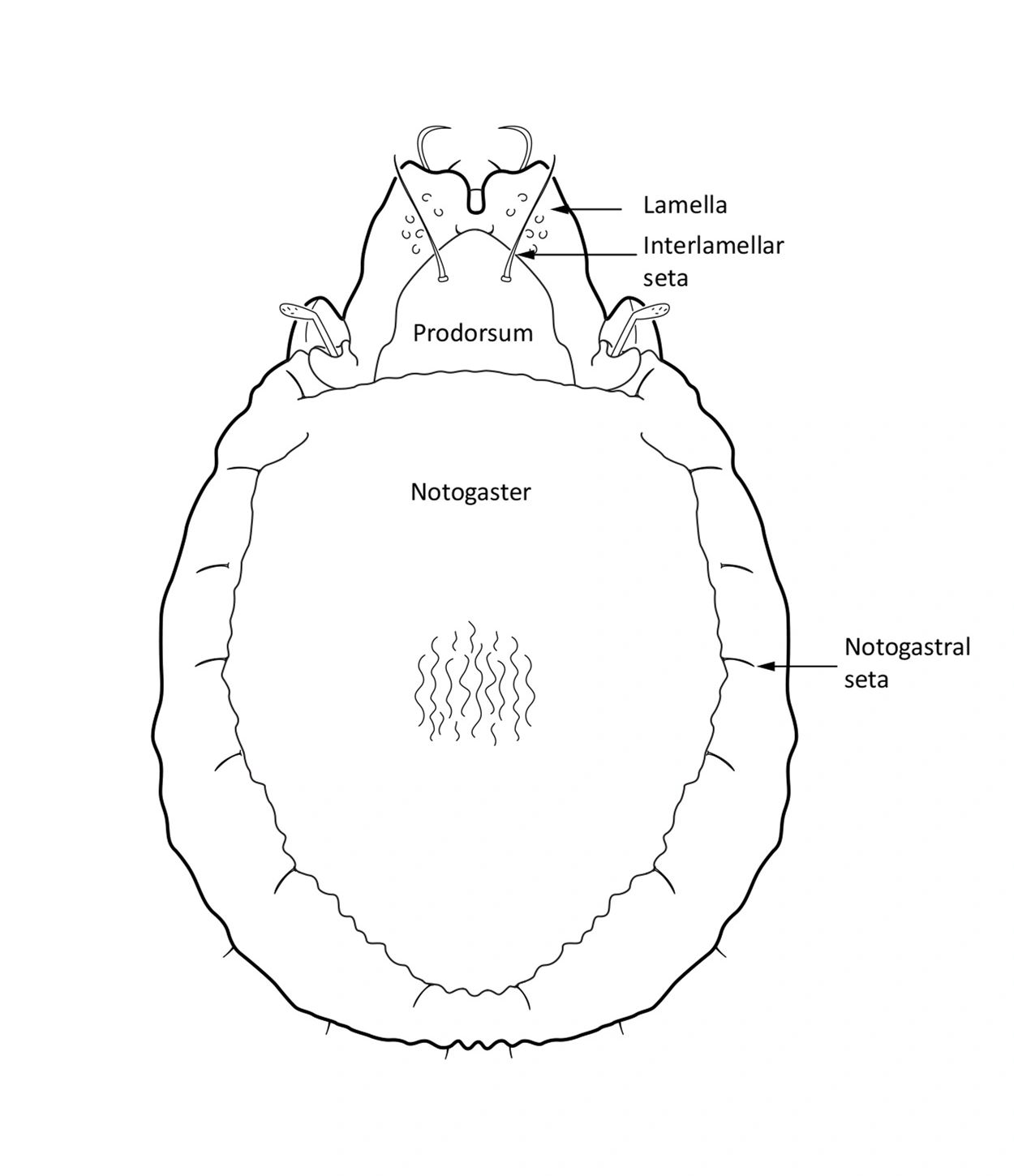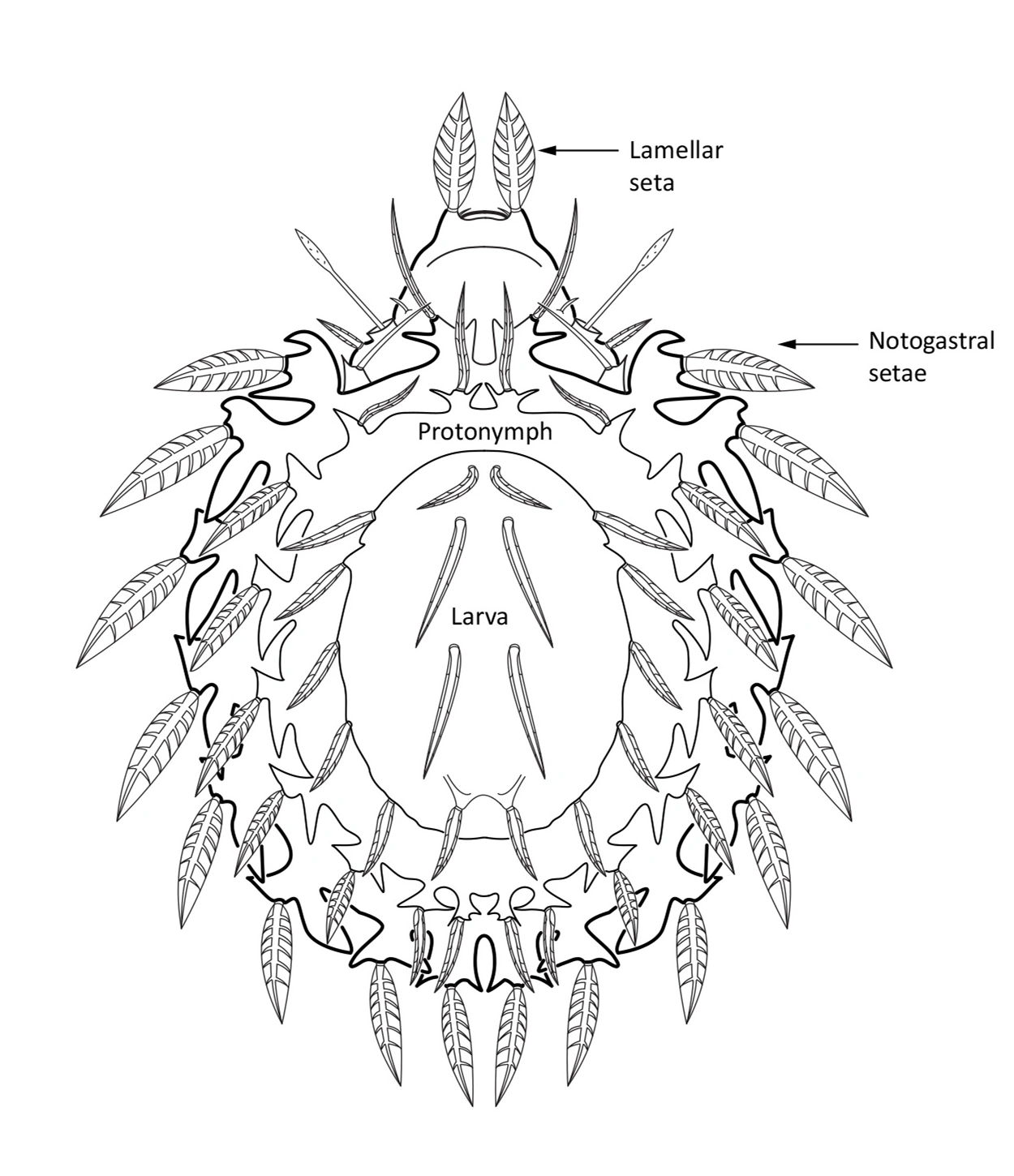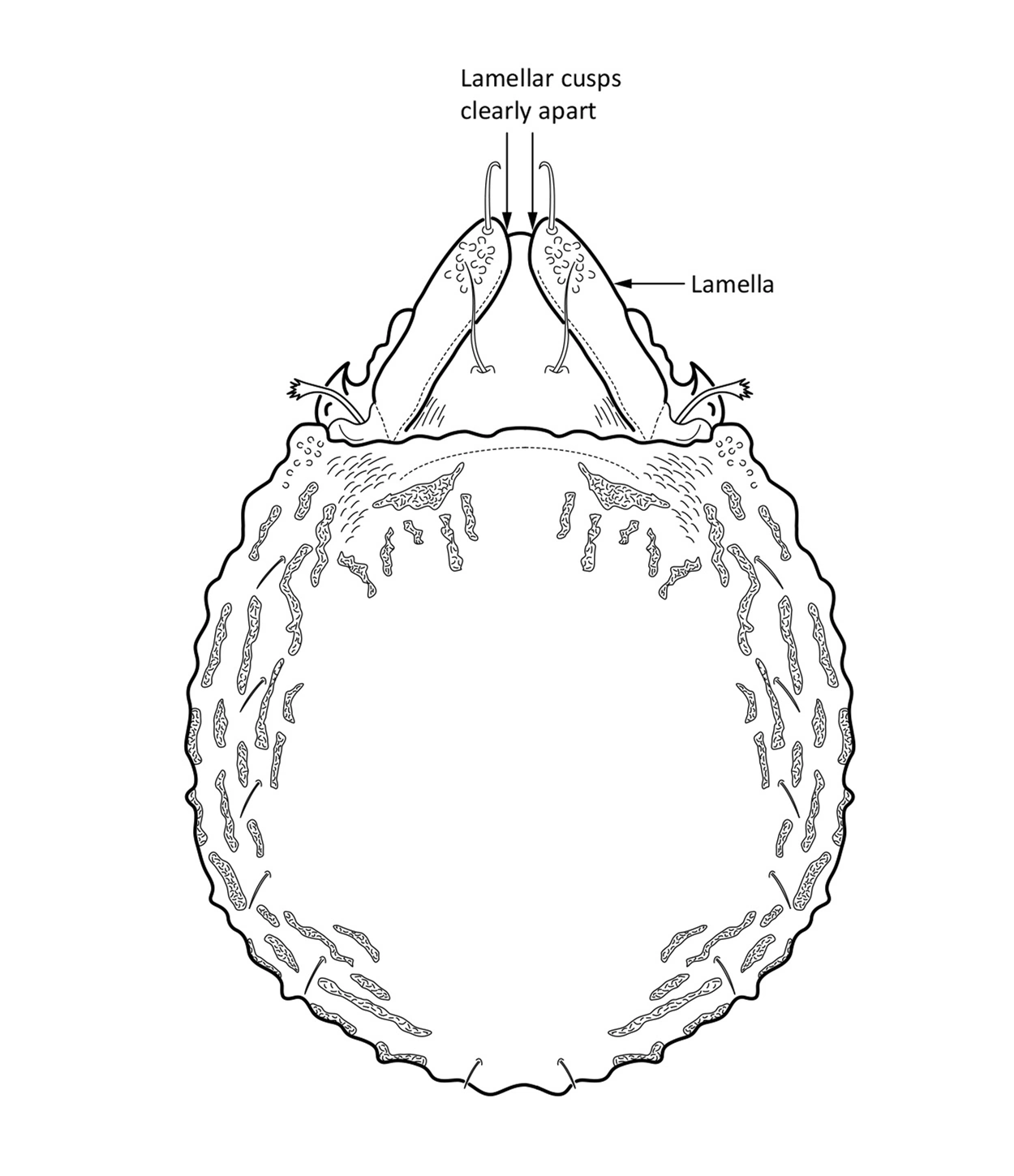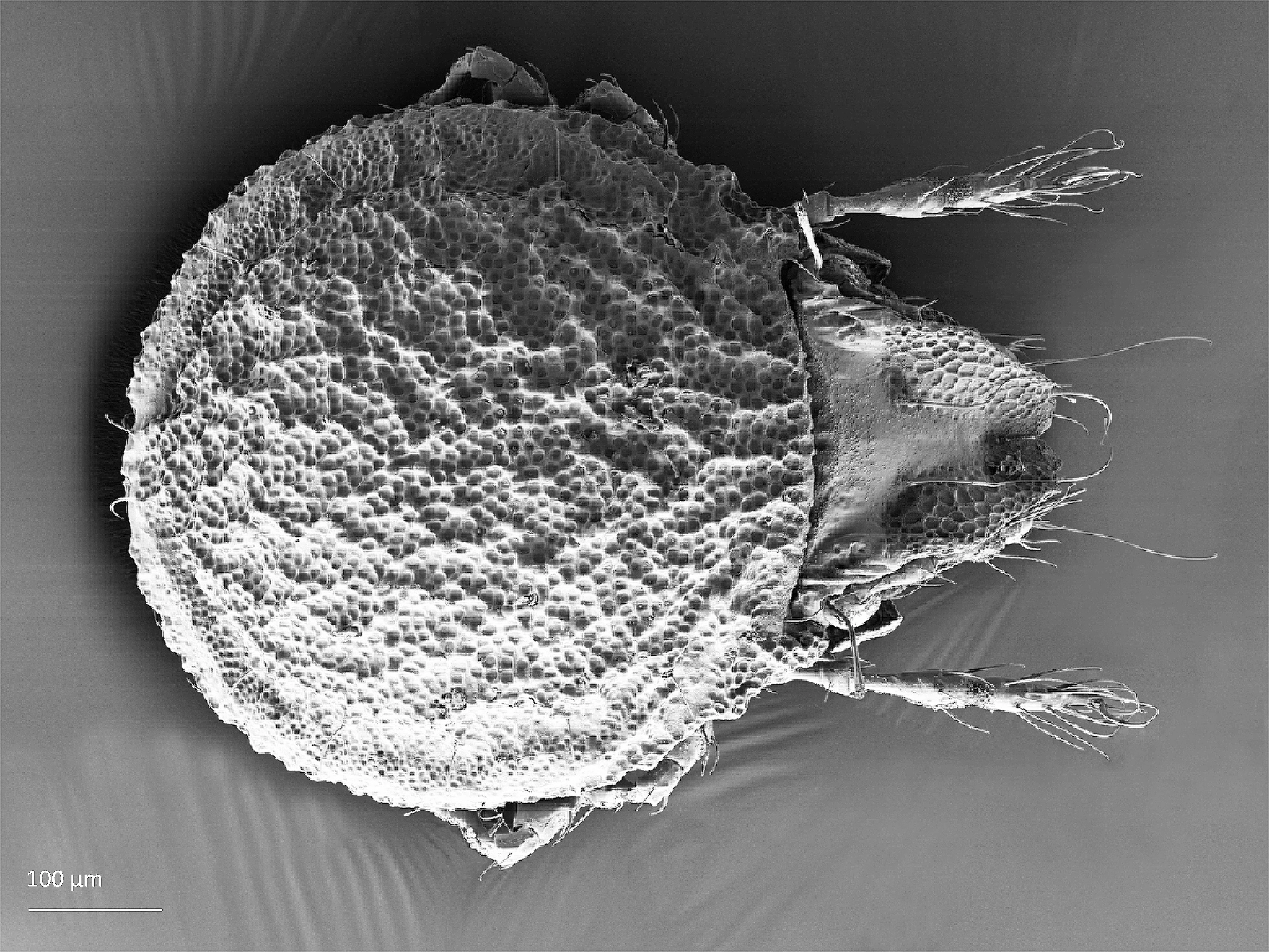Cepheus cepheiformis
Cepheus cepheiformis is often considered the most beautiful oribatid mite, because of the spectacular look of its juveniles. They have large, leaf-like setae and carry the exuviae, their “old skin”, of proceeding stages. Cepheus cepheiformis is eurytopic, it is found in different nature types, mostly in forest soil. In Norway it has been found rather seldom.
Description
Adult: The length of the body is 630–740 µm, and width is 430–520 µm. The color is reddish brown. It has feet with 1 claw (typical of genus Cepheus). The large lamellae cover the rostrum (Fig 1). The interlamellar setae are thin and slender. The anterior part of the prodorsum is covered by an areolate microsculpture. The notogastral microsculpture consists of curvy, predominantly longitudinal, folds. The notogaster bears 10 pairs of thin and short setae (Weigmann 2006).
Juvenile stages: Larva: body length 332–348 µm, width 149–166 µm. Protonymph: body length 381–398 µm, width 199–249 µm. Deutonymph: body length 464–481 µm, width 332–365 µm. Tritonymph: body length 564–647 µm, width 448–481 µm. The cuticle is colorless, with grayish and yellowish tint. The cerotegument (outer layer of cuticle) is finely granulate. It has very peculiar large, leaf-like notogastral and lamellar setae. In the nymphs the lamellar setae are inserted in rounded tubercles. The nymphs carry the exuviae (i.e. the remains of an exoskeleton and related structures) of proceeding stages (Fig. 2 – deutonymph is carrying exuviae of larva and protonymph) (Ermilov 2011).

Fig. 1. Dorsal view of Cepheus cepheiformis, adult.

Fig. 2. Dorsal view of Cepheus cepheiformis, juvenile.
Look-alikes

Fig. 3. Dorsal view of Cepheus latus, adult.
Adult Cepheus cepheiformis looks similar to Cepheus latus Koch, 1835 (Fig. 3), but it has lamellar cusps close to each other, while Cepheus latus has lamellar cusps clearly apart. Cepheus cepheiformis has interlamellar setae strong and pointed, while in Cepheus latus these setae are thin and bristle-shaped (Weigmann 2006).
Biology
Cepheus cepheiformis has sexual reproduction (Maraun et al. 2019). Its development time and feeding preferences are unknown.
Ecology
Distribution
The species is found in the Holarctic, which is northern continents of the world. It has also been found in Southeast China (Subías 2004).
Habitat
Cepheus cepheiformis is eurytopic (found in different habitats), mostly in forest soils but also in litter and on trees (Weigmann 2006).
Findings in Norway
In Norway it has been found rather seldom and has not been abundant in recent studies. It occurred for example in a wet broadleaf forest in Western Norway in moss on ground and on tree trunks (Thunes et al. 2004, A. Seniczak, pers. comm.).
References
Bernini F and Nannelli R (1982). Notulae oribatologicae XXVI. Contribution to the knowledge of the genus Cepheus (Oribatida, Acarida) in Italy. Redia 55, 155–188.
Ermilov SG (2011). Post-embrionic development of the oribatid mites Cepheus cepheiformis and Conchogneta traegardhi (Acari, Oribatida). Zoologichesky Zhurnal, 90, 1323–1337. [in Russian; English version: Entomological Review, 2012, 92, 112–126]
Maraun M, Caruso T, Hense J, Lehmitz L, Mumladze L, Murvanidze M, Nae I, Schulz J, Seniczak A and Scheu S (2019). Parthenogenetic vs. sexual reproduction in oribatid mite communities. Ecology and Evolution 9(12), 7324–7332. doi.org/10.1002/ece3.5303
Subías LS (2004). Listado sistemático, sinonímico y biogeográfico de los ácaros oribátidos (Acariformes, Oribatida) del mundo (excepto fósiles). Graellsia 60 (número extraordinario), 3–305.
Thunes KH, Skartveit J, Gjerde I, Starý J, Solhøy T, Fjellberg A, Kobro S, Nakahara S, zur Strassen R, Vierbergen G, Szadziewski R, Hagan DV, Grogan Jr WL, Jonassen T, Aakra K, Anonby J, Greve L, Aukema B, Heller K, Michelsen V, Haenni J-P, Emeljanov AF, Douwes P, Berggren K, Franzen J, Disney RHL, Prescher S, Johanson KA, Mamaev B, Podenas S, Andersen S, Gaimari SD, Nartshuk E, Søli GEE, Papp L, Midtgaard F, Andersen A, von Tschirnhaus M, Bächli G, Olsen KM, Olsvik H, Földvári M, Raastad JE, Hansen LO and Djursvoll P (2004). The arthropod community of Scots pine (Pinus sylvestris L.) canopies in Norway. Entomologica Fennica 15, 65–90.
Weigmann G (2006). Hornmilben (Oribatida). Die Tierwelt Deutschlands. 520 pp. Vol. 76, Goecke and Evers, Keltern.
Siden siteres som:
Seniczak A. Cepheus cepheiformis (Nicolet, 1855). www.artsdatabanken.no/Pages/286335. Nedlastet <dag/måned/år>
